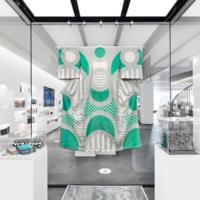Dear Alice:
My husband and I were touring Tokyo on my first trip to Japan when we suddenly found ourselves under a gigantic spider sculpture in Roppongi Hills. I was bewildered! I love to read about exciting structures and the stories behind them. Please tell me why the heck they put a spider there!
Mayuri G. Pune, India
That's "Maman," a massive sculpture that looms over the plaza in front of Mori Tower at Roppongi Hills. It is the work of Louise Bourgeois, a French-born artist who has lived in New York since 1938 and is now in her 90s. Maman means "mother" in French, and the artist designed the sculpture as an "ode" to her own mother. My heart went out to Madame Bourgeois when I heard that. I'm a mom myself and wouldn't be thrilled to know my kid thought of me as something huge, menacing and vaguely creepy.
But Louise Bourgeois has a more positive view of spiders. "My best friend was my mother and she was deliberate, clever, patient, soothing, reasonable, dainty, subtle, indispensable, neat and useful" as a spider, the artist once wrote. "She could also defend herself, and me."
"Maman" was designed in 1999 and cast in 2003. It's made of bronze except for the white marble eggs suspended under her belly. The sculpture stands 10 meters tall and weighs 11,000 kg. That's got to make it the mother lode of mother odes.
It was Minoru Mori himself, the developer of Roppongi Hills, who brought "Maman" to Tokyo. On a trip to London in 2000, Mr. Mori spotted an earlier casting of the sculpture at the opening of the Tate Modern and realized it was just what he was looking for.
"We had a very interesting set of challenges in trying to find a sculpture for the plaza in front of Mori Tower," Fumio Nanjo, deputy director of the Mori Art Museum, told me. "We wanted something memorable that people would want to take pictures of. At the same time, it had to be something recognizable and easy to describe so it could serve as a meeting spot, like Hachiko in Shibuya. But the sculpture couldn't be very heavy because the plaza is suspended, not build on solid ground. And it couldn't impede the flow of pedestrians across the plaza."
Bourgeois' spider was perfect but would it be safe in a country with earthquakes? Structural engineers determined it would and recommended it simply be placed on the plaza because fixing the legs in place could increase stress during an earthquake. And here's an eerie tidbit: Nanjo let slip that "Maman" has shifted from her original spot! The engineers can't figure out why. Maybe wind. Maybe vibrations on the plaza. Either way, Nanjo said it's not an issue now that she's resettled in one spot. Yeah, why worry about a gargantuan spider on the loose?
The developers weren't sure how the public would react to a giant spider so the initial contract was for just one year. But there were few complaints and visitors were quick to use the spider as a rendezvous point. So "Maman" is here to stay (unless she decides to pick up and move herself again).
Bourgeois authorized six castings of "Maman." Three others are in permanent collections, at the Leeum Samsung Museum of Modern Art in Seoul, South Korea, the Guggenheim Museum in Bilbao, Spain, and the National Gallery of Canada in Ottawa. The other two are currently on display in Russia and Cuba but have in the past crawled their way to London and New York. To pay a visit to Tokyo's very own, take the Hibiya subway line to Roppongi Station (exit 1C) and head up the long escalator to Roku-Roku Plaza. And if you want to meet a Japanese friend there, the phrase to use is "kumo no shita de aimasho" ("Let's meet under the spider").


















With your current subscription plan you can comment on stories. However, before writing your first comment, please create a display name in the Profile section of your subscriber account page.